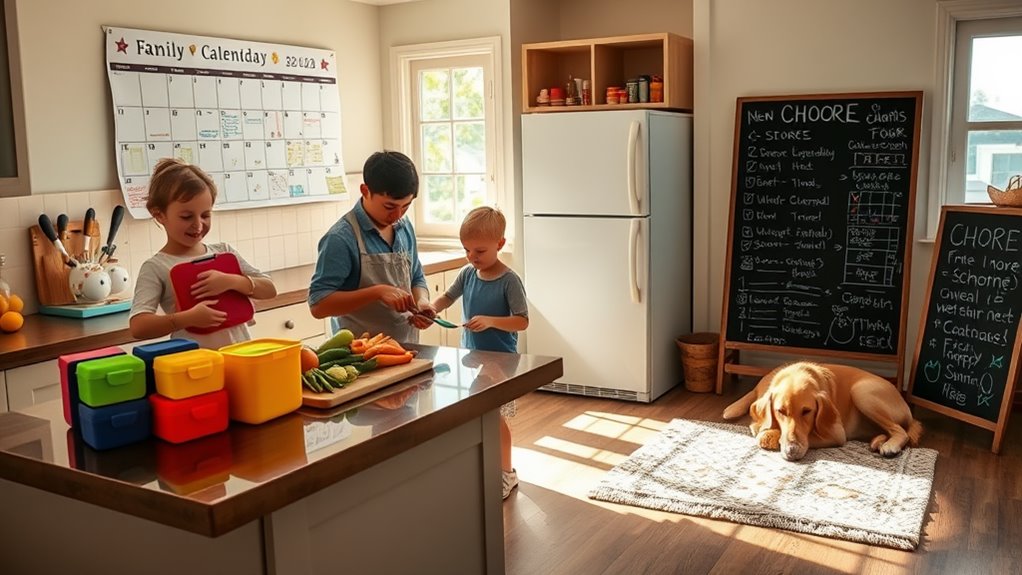The Family Routine That Keeps Chaos Under Control
A family routine acts like an anchor, keeping chaos at bay. By establishing a predictable schedule, you’ll bring stability and security to your household. Prioritize essential activities like wake-ups, meals, and wind-downs. Include everyone in the planning to foster commitment and responsibility. Visual aids like color-coded calendars can help everyone stay on track. Remember, flexibility is key—life happens, and routines may need adjusting. Celebrate small wins to encourage routine adoption. This structure not only reduces anxiety but also strengthens relationships. Curious about more ways to streamline your family life? There’s plenty more to explore!
Key Takeaways
- Establish consistent daily routines to provide stability and reduce anxiety among family members.
- Prioritize core activities like meals, school, and work to create a structured schedule.
- Include buffer times between tasks to accommodate unexpected delays and maintain flow.
- Involve family members in planning to encourage commitment and ownership of the routine.
- Regularly reassess and adjust routines to adapt to changing family needs and circumstances.
Benefits of Family Routines
Family routines offer numerous benefits that can enhance your household’s overall well-being. When you establish consistent patterns, you create a sense of stability and security for your family. This predictability helps reduce anxiety and fosters a supportive environment where everyone can thrive.
Routines also encourage responsibility, as family members learn to contribute and participate in daily tasks. You’ll find that having designated times for meals, homework, and family activities can improve communication and strengthen relationships.
Additionally, routines help in managing time effectively, making it easier to balance work, chores, and leisure. By prioritizing routines, you’re not just organizing your day; you’re cultivating a nurturing atmosphere that promotes harmony and cooperation among family members.
Key Elements of Effective Schedules
To create an effective schedule, it’s essential to prioritize flexibility while maintaining structure.
Start by identifying your family’s core activities, like school, work, and meal times. Block out these key events first, then fill in the gaps with other responsibilities and leisure activities.
Make sure to include buffer times between tasks to account for unexpected delays or changes. Encourage everyone in the family to contribute ideas, ensuring buy-in and commitment to the schedule.
Visual aids, like a color-coded calendar, can help everyone stay on track. Finally, review and adjust your schedule regularly to reflect your family’s evolving needs, ensuring that it remains relevant and effective.
This balance of structure and adaptability will help keep chaos at bay.
Tips for Establishing Routines
While establishing routines may seem challenging, breaking it down into manageable steps can make the process smoother and more effective.
Start by identifying key activities that need structure, like morning wake-ups and evening wind-downs. Next, set clear times for these activities, ensuring they fit your family’s lifestyle. Consistency is essential, so aim to stick with the schedule as much as possible.
Don’t forget to keep things flexible; life happens, and that’s okay! You can also use visual aids, like charts or calendars, to help everyone stay on track.
Finally, celebrate small successes along the way. This positive reinforcement will encourage your family to embrace routines, making them feel less like chores and more like a natural part of daily life.
Involving Children in Planning
Involving children in planning routines can significantly enhance their engagement and ownership of daily activities. When kids participate, they’re more likely to follow through and feel responsible.
Here are some practical ways to involve them:
-
Hold Family Meetings****: Set aside time each week to discuss upcoming activities and chores.
-
Create a Visual Schedule****: Use charts or drawings to help them see their responsibilities.
-
Choose Activities Together: Let them pick fun family activities or meals for the week.
-
Assign Age-Appropriate Tasks: Give them specific duties that match their abilities, fostering a sense of accomplishment.
Adjusting Routines as Needed
Adjusting routines as needed is essential for maintaining a balanced family life. Life’s unpredictability means you can’t always stick to the original plan.
When unexpected events arise, like a child falling ill or a last-minute work commitment, be flexible and ready to adapt. Communicate with your family about the changes, so everyone stays informed and feels involved.
You might need to shift mealtimes, adjust homework schedules, or even change weekend plans. Embrace these adjustments as opportunities to teach your kids about resilience and adaptability.
Regularly reassess your routines to guarantee they still serve your family’s needs. By being open to change, you’ll create a more harmonious environment and help your family thrive amid life’s chaos.
Frequently Asked Questions
How Long Does It Take to Establish a Family Routine?
It usually takes a few weeks to establish a family routine. You’ll need consistency and patience, but as everyone adapts, you’ll notice smoother days. Stick with it, and soon it’ll feel natural for everyone.
What Should I Do if My Child Resists Routines?
If your child resists routines, try involving them in the planning. Ask for their input, make it fun, and be flexible. It helps create a sense of ownership and can make them more cooperative.
Can Routines Be Too Rigid or Strict?
Yes, routines can be too rigid. When you enforce strict schedules, it might create stress or resistance. Flexibility allows you to adapt to your child’s needs, making routines more enjoyable and effective for everyone involved.
How Often Should We Review Our Family Routine?
You should review your family routine regularly, ideally every few months. This way, you can assess what’s working, make necessary adjustments, and guarantee it continues to meet everyone’s needs while adapting to changes in your lives.
What Are Signs That Our Routine Needs Adjustment?
You’ll notice signs like increased stress, missed activities, or constant arguments. If family members seem disengaged or overwhelmed, it’s time to reassess. Recognizing these indicators can help you create a more harmonious routine.




